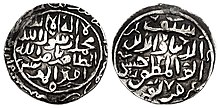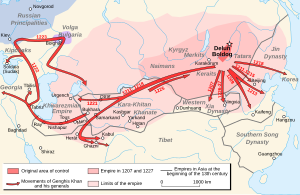| al-Ẓāhir bi-Amr Allāh الظاهر بأمر الله | |||||
|---|---|---|---|---|---|
| Khalīfah Amir al-Mu'minin | |||||
 Coinage of Saif al-Din al-Hasan (1239–1249), ruler of the Qarlughids. Sindh mint. In the name of the Abbasid Caliph, al-Zahir. Struck in 1225-1226 CE. Coinage of Saif al-Din al-Hasan (1239–1249), ruler of the Qarlughids. Sindh mint. In the name of the Abbasid Caliph, al-Zahir. Struck in 1225-1226 CE. | |||||
| 35th Caliph of the Abbasid Caliphate Abbasid Caliph in Baghdad | |||||
| Reign | 5 October 1225 – 10 July 1226 | ||||
| Predecessor | al-Nasir | ||||
| Successor | al-Mustansir | ||||
| Born | 1175 Baghdad (Iraq) | ||||
| Died | 11 July 1226 (aged 51) Baghdad | ||||
| Burial | Baghdad | ||||
| Consort | Bab Jawhar Hayat Khatun Zahra | ||||
| Issue | Mansur al-Mustansir | ||||
| |||||
| Dynasty | Abbasid | ||||
| Father | al-Nasir | ||||
| Mother | Asma | ||||
| Religion | Sunni Islam | ||||
Abū Nasr Muhammad ibn al-Nāsir (Arabic: أبو نصر محمد بن الناصر; 1175 – 11 July 1226), better known with his regnal name al-Ẓāhir bi-Amr Allāh (الظاهر بأمر الله, lit. 'He Who Appears Openly by the Order of God'), was the Abbasid caliph in Baghdad from 1225 to 1226. He succeeded his father al-Nasir in the year 1225 as the thirty-fifth Abbasid Caliph.
Biography
Al-Zahir bi-Amr Allah was the son of al-Nasir and Asma Umm Muhammad. His full name was Muhammad ibn Ahmad al-Nāsir and his Kunya was Abu Nasr. He was named as successor in 1189. In his short reign, he lowered the taxes, and built a strong army to resist invasions. He died on 10 July 1226, nine months after his accession.
Mongol invasion of Khwarezmia
When it became known that Genghis Khan was marching towards Khwarazm, Jalal al-Din proposed to his father to meet the Mongols in one decisive battle near the Syr Darya. However, Muhammad II relied on his well-fortified fortresses and did not assemble troops, distributing them instead among the major towns of his empire. Meanwhile, the Mongols swiftly took one city after another. At the beginning of 1220, Bukhara fell, followed by Samarqand. Muhammad started to retreat west, and after a series of unsuccessful battles, was left with a handful of soldiers and his sons. The huge and undisciplined Khwarazmian army was unable to defeat the enemy, which was much inferior in number.
Legend has it that Muhammad, who fled to the Caspian Sea, being terminally ill, gathered his sons: Jalal ad-Din, Aqshah, and Uzlagh Khan and announced that he appointed Jalal ad-Din as heir to the throne, because only he could confront the enemy. Summoning the younger sons to obedience, he hung his sword on the belt of Jalal ad-Din. A few days later, Muhammad died and Jalal ad-Din was proclaimed a Khwarazmshah.
Following the defeat of his father, Ala ad-Din Muhammad II by Genghis Khan in 1220, Jalal ad-Din Mingburnu came to power and retreated with the remaining Khwarazm forces, while pursued by a Mongol army and at the Battle of Parwan, north of Kabul, defeated the Mongols.

Due to the Mongol invasion, the sacking of Samarkand and being deserted by his Afghan allies, Jalal ad-Din was forced to flee to India. At the Indus River, however, the Mongols caught up with him and slaughtered his forces, along with thousands of refugees, at the Battle of the Indus. He escaped and sought asylum in the Sultanate of Delhi but Iltutmish denied this to him in deference to the relationship with the Abbasid caliphs. The cities of Herat, Ghazni and Merv were destroyed and massacred by the Mongols, for his resistance or rebelliousness.
Family
One of al-Zahir's concubines was Hayat Khatun. She was of Turkish origin, a favored and trusted concubine, and the mother of one of his sons. She was manumitted upon his death and became a free woman. She died on 16 August 1241, and was buried in the mausoleum of the caliph al-Mustadi. Another of his concubines was Bab Jawhar. She was a Turkish slave who was also a favorite of al-Zahir. She died on 1 August 1241, and was buried near the caliphal tombs in the Rusafah Cemetery. Another of his concubines was a Turkish slave. She was the mother of the future Caliph al-Mustansir. Al-Zahir's other notable son was Abu al-Qasim Ahmad.
Succession
Al-Zahir was succeeded by al-Mustansir bi-llah.
See also
- Al-Sarai Mosque built by his father al-Nasir.
- Zumurrud Khatun Mosque and Mausoleum was built by his grandmother.
- Mausoleum of Umar Suhrawardi
- Muhammad bin Hasan al-Baghdadi
References
- Gudogdyev, Ovez. "Historical and Cultural Heritage of Turkmenistan: Encyclopedic Dictionary". Istanbul. 2000. pages 381; ISBN 9789759725600
- Man, John (2004). Genghis Khan: Life, Death, and Resurrection. St. Martin's Press. p. 181. ISBN 0-312-31444-2.
- Dupuy, Trevor N.; Dupuy, R. Ernest (1993). The Harpers Encyclopedia of Military History. Harper Collins. p. 366. ISBN 0-06-270056-1.
- ^ al-Sāʿī, Ibn; Toorawa, Shawkat M.; Bray, Julia (2017). كتاب جهات الأئمة الخلفاء من الحرائر والإماء المسمى نساء الخلفاء: Women and the Court of Baghdad. Library of Arabic Literature. NYU Press. pp. 75–76. ISBN 978-1-4798-6679-3.
- Rizvi, Sayyid Saeed Akhtar; Shou, Salman (2005). Utumwa: Mtazamo wa Kiislamu na wa Nchi za Magharibi. Al-Itrah Foundation. p. 64. ISBN 978-9987-9022-4-8.
- Hasan, M. (1998). History of Islam: Classical period, 571-1258 C.E. History of Islam. Islamic Publications. p. 304.
- This text is adapted from William Muir's public domain, The Caliphate: Its Rise, Decline, and Fall.
| al-ZahirAbbasid dynastyCadet branch of the Banu HashimBorn: 1175 Died: 11 July 1226 | ||
| Sunni Islam titles | ||
|---|---|---|
| Preceded byal-Nasir | Caliph of Islam Abbasid Caliph 5 October 1225 – 11 July 1226 |
Succeeded byal-Mustansir |